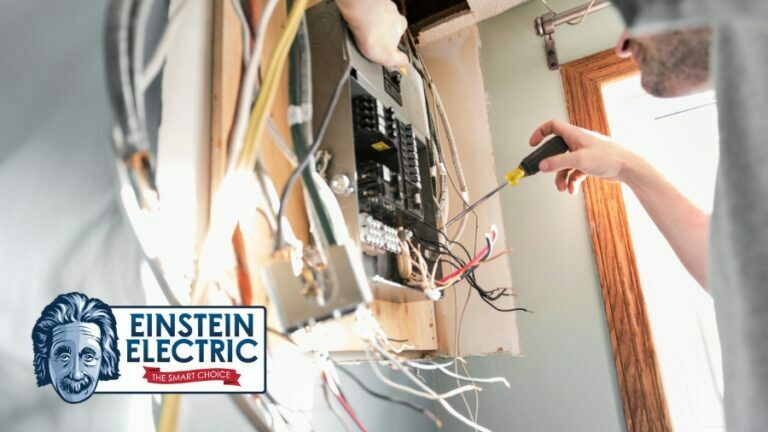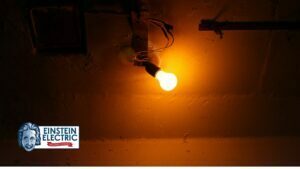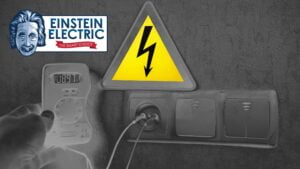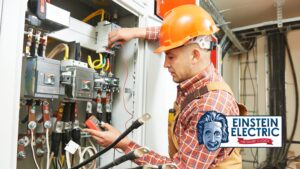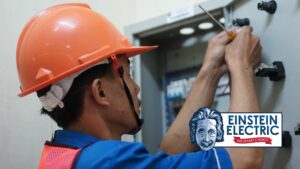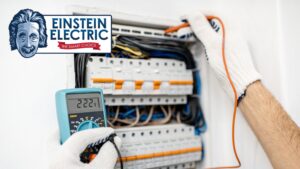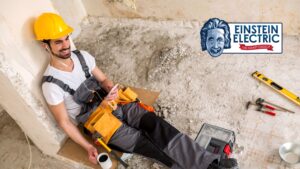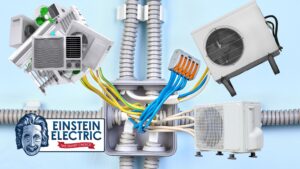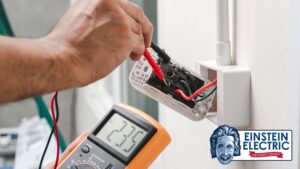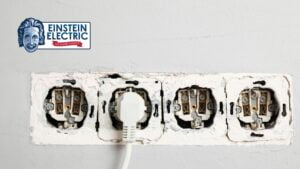Upgrading your home’s electrical system is an essential task that homeowners should consider for various reasons. Whether your home is old and requires modernization or you simply want to improve safety and efficiency, understanding the basics of electrical upgrades is crucial. In this blog post, we will explore the key aspects of upgrading your home’s electrical system and provide you with the information you need to know.
- Assessing the Need for an Upgrade:
Before embarking on an electrical upgrade project, it’s essential to assess whether your home’s electrical system requires attention. Look out for warning signs such as frequent tripping of circuit breakers, flickering lights, outlets that don’t work, or outdated components. These issues can indicate underlying problems and signify the need for an upgrade.
Here are some factors to consider when evaluating if an upgrade is necessary:
- Age of the Electrical System: Older homes, particularly those built several decades ago, may still have outdated electrical systems that are not designed to handle the demands of modern technology and appliances. If your home is more than 20-30 years old and has never undergone an electrical upgrade, it’s likely time to consider one.
- Frequently Tripping Circuit Breakers: If you experience frequent circuit breaker tripping, it may be an indication that your electrical system is overloaded. This can happen if you have added new appliances or devices that draw a significant amount of power. Upgrading your electrical system can help distribute the electrical load more effectively, reducing the instances of tripping breakers.
- Flickering Lights: Lights that flicker or dim unexpectedly can be a sign of electrical issues. It may indicate problems with the electrical wiring, loose connections, or insufficient power supply. An electrical upgrade can address these issues and ensure a stable and consistent power supply to your lighting fixtures.
- Outdated Electrical Panel: The electrical panel is the heart of your home’s electrical system. If your electrical panel is old, has outdated technology, or lacks the capacity to meet your current power demands, it’s time to consider an upgrade. An updated panel will provide additional circuits, improved safety features, and compatibility with modern appliances and technologies.
- Insufficient Outlets: In older homes, the number of electrical outlets may not be adequate to support the growing number of electronic devices we use today. If you find yourself relying on power strips and extension cords to accommodate your devices, it’s a clear indication that additional outlets are needed. An electrical upgrade can help increase the number of outlets and ensure they are properly distributed throughout your home.
- Safety Concerns: If you have concerns about the safety of your electrical system, it’s crucial to address them promptly. This includes issues such as exposed wiring, outdated wiring materials (such as knob and tube or aluminum wiring), and lack of proper grounding. An electrical upgrade can help mitigate safety risks and ensure your home meets current electrical safety standards.
- Home Renovations or Additions: If you’re planning to renovate your home or add new rooms, it’s an opportune time to consider an electrical upgrade. Upgrading your electrical system during renovations ensures that the electrical infrastructure can support the increased power demands and meets the necessary codes and regulations.
Remember, it’s always best to consult with a licensed electrician to assess the condition of your electrical system and determine the specific upgrades needed. They can conduct a thorough inspection, identify potential issues, and provide recommendations tailored to your home’s electrical requirements.
- Hiring a Professional Electrician:
While some homeowners may consider DIY electrical projects, it is highly recommended to hire a licensed and experienced electrician for any electrical upgrades. A professional electrician possesses the knowledge, skills, and expertise to handle complex electrical work safely and efficiently, ensuring compliance with local electrical codes.
Here are several reasons why you should choose a licensed and experienced electrician for your electrical projects:
- Safety: Dealing with electricity can be dangerous if not handled properly. Licensed electricians undergo rigorous training and have the necessary expertise to work safely with electrical systems. They understand electrical codes and regulations and follow safety protocols to ensure that the work is done safely and to a high standard.
- Knowledge and Experience: Professional electricians have extensive knowledge and experience in working with electrical systems. They are well-versed in electrical theory, wiring techniques, and troubleshooting electrical problems. This expertise allows them to assess your home’s electrical system accurately, identify any issues or deficiencies, and provide appropriate solutions.
- Compliance with Electrical Codes: Electrical work must adhere to specific codes and regulations to ensure safety and prevent hazards. Licensed electricians are familiar with these codes and regulations and ensure that all work is performed in compliance. Hiring an electrician ensures that your electrical upgrades meet the necessary standards and pass inspections.
- Problem Identification and Troubleshooting: Electricians have the skills to identify and diagnose electrical problems effectively. They can troubleshoot issues such as faulty wiring, overloaded circuits, or inadequate grounding. Their expertise allows them to provide comprehensive solutions and address any underlying electrical issues during the upgrade process.
- Efficiency and Time Savings: Professional electricians are efficient in completing electrical upgrades due to their experience and knowledge. They have the necessary tools, equipment, and resources to work efficiently, saving you time and effort. By hiring an electrician, you can expect the project to be completed in a timely manner while ensuring quality workmanship.
- Warranty and Insurance: Reputable electricians typically offer warranties on their work, providing you with peace of mind. In case any issues arise after the upgrade, they can rectify them without additional costs. Additionally, professional electricians carry liability insurance, protecting you from any potential damages or accidents that may occur during the project.
- Long-Term Cost Savings: While hiring a professional electrician may require an upfront investment, it can lead to long-term cost savings. A properly upgraded electrical system improves energy efficiency, reduces the risk of electrical issues and accidents, and prevents costly repairs down the line. Moreover, professional work is less likely to require frequent maintenance or corrections, saving you money in the long run.
Remember, always choose a licensed and reputable electrician for your electrical projects. Research local electricians, check their credentials, read reviews, and ask for references. By hiring a professional, you can ensure a safe, efficient, and successful electrical upgrade for your home.
- Identifying the Scope of the Upgrade:
Once you’ve decided to upgrade your home’s electrical system, it’s crucial to identify the scope of the project. This involves assessing which components need upgrading, such as the electrical panel, wiring, outlets, switches, and lighting fixtures. A thorough evaluation will help you determine the extent of the work required and allocate the necessary resources.
Identifying the scope of your electrical system upgrade is a crucial step in planning and executing the project effectively. Here are some key considerations to help you determine the scope:
- Evaluate Existing System: Start by assessing your home’s current electrical system. Take note of the age, condition, and capacity of the electrical panel, wiring, outlets, switches, and other components. Identify any specific issues or deficiencies that need to be addressed during the upgrade.
- Consider Power Demands: Determine your current and future power needs. Think about the appliances, devices, and electronics you use in your home, as well as any anticipated additions or changes. This assessment will help you determine if your electrical system can adequately support the power demands or if an upgrade is necessary.
- Safety Upgrades: Consider safety improvements as part of the upgrade. This may include replacing outdated wiring, upgrading to modern circuit breakers with ground fault circuit interrupters (GFCIs) and arc fault circuit interrupters (AFCIs), improving grounding, or installing smoke detectors and carbon monoxide detectors. Assess the safety features you want to incorporate into the upgraded system.
- Energy Efficiency Goals: Assess your energy efficiency goals and determine if you want to incorporate energy-saving measures into the upgrade. This could involve replacing traditional incandescent bulbs with energy-efficient LED lights, installing programmable thermostats, or considering smart home integration for energy management. Determine the extent to which energy efficiency will be a focus of the upgrade.
- Aesthetic Considerations: Evaluate any aesthetic upgrades you may want to incorporate. This could involve replacing outdated switches and outlets with modern designs, adding dimmer switches for improved lighting control, or selecting fixtures that enhance the overall visual appeal of your home. Consider how these aesthetic upgrades align with your overall goals for the electrical system upgrade.
- Budget and Timeline: Determine your budget and establish a timeline for the project. Consider the financial resources you have available and prioritize the upgrades based on their importance and urgency. Additionally, consider any time constraints or specific deadlines you need to work within.
- Consultation with a Licensed Electrician: It is highly recommended to consult with a licensed electrician to assess your electrical system and discuss your upgrade goals. They can provide professional guidance, evaluate the current system, and provide recommendations tailored to your specific needs. An electrician can help you understand the feasibility, costs, and technical aspects of the upgrade, ensuring a comprehensive understanding of the project’s scope.
By carefully evaluating these factors, you can identify the scope of your electrical system upgrade. This will help you plan the project effectively, ensure that all necessary components are addressed, and achieve your desired outcomes in terms of safety, functionality, energy efficiency, and aesthetics.
- Upgrading the Electrical Panel:
The electrical panel serves as the control center for your home’s electrical system. If your current panel is outdated or insufficient to meet your power demands, upgrading to a modern panel is essential. An upgraded panel will provide increased capacity, improved safety features, and compatibility with modern electrical appliances and technologies.
Here are some key points to consider when upgrading the electrical panel:
- Capacity and Power Demand: Evaluate the capacity of your existing electrical panel and compare it to your current and future power demands. If you frequently experience tripped breakers or find that your electrical system struggles to handle multiple appliances and devices simultaneously, it may be a sign that your panel is insufficient. Upgrading to a panel with higher amperage capacity can ensure a reliable and efficient power supply.
- Compatibility with Modern Appliances: Older electrical panels may not be equipped to handle the power requirements of modern appliances and electronics. If you’ve recently added energy-intensive devices such as air conditioners, electric vehicles, or home entertainment systems, it’s important to upgrade your panel to accommodate these higher loads safely. A modern electrical panel will provide the necessary circuits and capacity to support your modern lifestyle.
- Safety Enhancements: Upgrading the electrical panel offers an opportunity to improve safety features. Older panels may lack essential safety components such as ground fault circuit interrupters (GFCIs) or arc fault circuit interrupters (AFCIs). GFCIs protect against electrical shocks in areas where water is present, such as kitchens and bathrooms, while AFCIs help prevent electrical fires caused by arcing faults. Upgrading your panel allows for the inclusion of these vital safety measures.
- Compliance with Electrical Codes: Electrical codes and regulations are constantly updated to ensure safety standards are met. If your current electrical panel doesn’t comply with the latest codes, upgrading to a modern panel will bring your home up to code. Compliance is important not only for your safety but also if you plan to sell your home in the future, as non-compliant electrical systems can be a deterrent for potential buyers.
- Expansion and Future-Proofing: If you have plans to expand or renovate your home in the future, it’s wise to upgrade your electrical panel to accommodate those changes. By installing a panel with additional breaker slots and capacity, you can avoid potential limitations when adding new circuits or rooms. Future-proofing your electrical system saves you the hassle and cost of upgrading again when you make future home improvements.
- Professional Installation: Upgrading the electrical panel is a complex task that should be handled by a licensed electrician. They have the knowledge, experience, and skills to safely install the new panel and ensure that all connections are properly made. A professional installation not only guarantees compliance with electrical codes but also minimizes the risk of electrical hazards during and after the upgrade.
Remember, upgrading the electrical panel is not a DIY project. Always consult with a licensed electrician who can assess your specific needs, recommend an appropriate panel size, and ensure a safe and reliable installation. By upgrading your electrical panel, you enhance the capacity, safety, and efficiency of your home’s electrical system, providing a solid foundation for your electrical upgrades.
- Rewiring and Circuit Upgrades:
Outdated or damaged wiring can pose significant safety risks. Consider rewiring your home if you have knob and tube wiring, aluminum wiring, or outdated electrical cables. Additionally, upgrading to modern circuit breakers, such as ground fault circuit interrupters (GFCIs) and arc fault circuit interrupters (AFCIs), enhances the safety of your electrical system by preventing electrical shocks and fires.
Outdated or damaged wiring can pose significant safety risks. Consider rewiring your home if you have knob and tube wiring, aluminum wiring, or outdated electrical cables.
Rewiring your home and upgrading circuits is a critical aspect of improving your home’s electrical system. Here’s what you need to know about rewiring and circuit upgrades:
- Types of Outdated Wiring: Several types of outdated wiring can pose safety risks and may require rewiring:
- Knob and Tube Wiring: This type of wiring was commonly used in homes built before the 1950s. It consists of ceramic knobs and tubes that support the wires. Knob and tube wiring is not grounded and may have degraded insulation, making it a fire hazard. Rewiring is highly recommended to replace this outdated system with modern, safer wiring.
- Aluminum Wiring: Homes built in the 1960s and 1970s may have aluminum wiring, which was popular due to its cost-effectiveness. However, aluminum wiring is prone to overheating and can cause fire hazards if not properly installed or maintained. Upgrading to copper wiring or using approved aluminum wiring techniques can mitigate these risks.
- Outdated Electrical Cables: Even if your home doesn’t have knob and tube or aluminum wiring, outdated electrical cables with degraded insulation can also pose safety concerns. If your home has old cloth-covered wiring, it’s advisable to have it replaced with modern wiring materials to ensure safety and reliability.
- Safety Considerations: Outdated or damaged wiring increases the risk of electrical fires, shocks, and short circuits. It can also lead to power fluctuations, flickering lights, and frequent tripping of circuit breakers. If you notice any of these signs or have concerns about the safety of your wiring, it’s crucial to address them promptly by considering a rewiring project.
- Increased Capacity and Load Distribution: Rewiring your home allows for increased capacity and improved load distribution. It enables you to accommodate modern power demands and support the use of multiple appliances, devices, and electronics simultaneously without overloading the electrical system. By upgrading circuits, you can distribute the electrical load more effectively and reduce the risk of circuit overloads and tripped breakers.
- Compliance with Electrical Codes: Rewiring your home provides an opportunity to bring your electrical system up to current electrical codes and regulations. Compliance with these codes ensures the safety and integrity of the electrical installation. It is especially important if you plan to sell your home or if you want to ensure that your electrical system meets the standards set by local authorities.
- Professional Assessment and Installation: Rewiring a home is a complex task that requires the expertise of a licensed electrician. A professional electrician can assess the condition of your existing wiring, determine the scope of the rewiring project, and develop a comprehensive plan for installation. They will ensure that the new wiring is properly installed, grounded, and meets all safety requirements.
- Timing and Planning: Rewiring a home can be a disruptive process as it may involve cutting into walls, ceilings, and floors. It is important to plan the rewiring project carefully, taking into consideration the impact on your daily activities and minimizing disruptions. Discuss the timeline, budget, and logistics with your electrician to ensure a smooth and efficient process.
By rewiring your home and upgrading circuits, you eliminate the risks associated with outdated or damaged wiring and ensure the safety and reliability of your electrical system. Consult with a licensed electrician to assess your specific needs and develop a plan for rewiring that meets your home’s requirements and adheres to electrical codes and regulations.
- Upgrading Outlets and Switches:
Updating your home’s outlets and switches not only enhances the aesthetics but also improves functionality and safety. Replace old outlets with modern ones that include built-in USB ports or GFCI protection for added convenience and safety in wet areas like bathrooms and kitchens. Upgrade switches to dimmers for better lighting control and energy efficiency.
Here are some key points to consider when upgrading outlets and switches:
- Aesthetic Improvements: Outdated outlets and switches can detract from the overall appearance of your home. Upgrading to modern outlets and switches can give your space a fresh, updated look. Consider options such as sleek, screwless wall plates, stylish designs, or even smart outlets and switches that offer advanced features and integration with home automation systems. Choosing outlets and switches that complement your home’s décor can significantly enhance its visual appeal.
- Enhanced Functionality: Upgrading outlets and switches can also improve functionality. Consider installing additional outlets in areas where you currently rely on power strips or extension cords. This ensures that you have easy access to power where you need it most. You can also consider installing USB outlets, which allow you to charge devices directly without the need for adapters. Additionally, upgrading to dimmer switches can provide greater control over lighting levels and create ambiance in your living spaces.
- Ground Fault Circuit Interrupters (GFCIs): GFCIs are an important safety feature, especially in areas exposed to moisture, such as bathrooms, kitchens, garages, and outdoor spaces. Upgrading outlets to GFCIs helps protect against electrical shocks by quickly detecting ground faults and cutting off power. This is particularly crucial near water sources to prevent accidents and ensure electrical safety.
- Tamper-Resistant Outlets: If you have children or anticipate having young visitors in your home, tamper-resistant (TR) outlets are highly recommended. TR outlets have built-in mechanisms that prevent foreign objects from being inserted into the slots, reducing the risk of electrical shocks or burns. Upgrading to TR outlets ensures an added layer of safety for your family and guests.
- Compatibility with Modern Devices: Today’s technology relies heavily on power-hungry devices such as smartphones, tablets, laptops, and gaming consoles. Upgrading outlets with built-in USB ports or adding USB adapters can provide convenient charging options for these devices without occupying valuable outlet space. This allows you to keep your devices powered up and ready to use.
- Professional Installation: While replacing outlets and switches may seem like a straightforward task, it’s essential to have them installed by a licensed electrician. A professional electrician ensures that the wiring is properly connected, grounded, and meets electrical codes and safety standards. They will also perform necessary tests to ensure that the upgraded outlets and switches function correctly and safely.
- Energy Efficiency Considerations: When upgrading outlets and switches, consider energy-efficient options. Look for outlets and switches that are energy-saving rated or equipped with energy-saving features. These devices can help reduce energy consumption and contribute to a more eco-friendly home.
Remember, electrical work should always be carried out by a licensed electrician. They can provide expert advice on outlet and switch options, assist with the installation, and ensure that all safety measures and regulations are met. By upgrading your outlets and switches, you improve both the functionality and safety of your home’s electrical system while adding a touch of modernity to your living spaces.
- Energy Efficiency Considerations:
Electrical system upgrades provide an excellent opportunity to improve energy efficiency in your home. Consider replacing traditional incandescent bulbs with energy-efficient LED lights, which consume less electricity and have a longer lifespan. Additionally, installing programmable thermostats and motion sensor switches can help reduce energy waste.
Here are some key energy efficiency considerations for your electrical system upgrades:
- Lighting: Lighting accounts for a significant portion of your home’s energy consumption. Consider upgrading to energy-efficient LED (Light Emitting Diode) bulbs. LED bulbs use significantly less energy than traditional incandescent bulbs and have a much longer lifespan. Additionally, explore options such as motion-sensor lighting or dimmer switches to optimize lighting usage and reduce unnecessary energy consumption.
- Appliances and Electronics: Energy-efficient appliances and electronics can have a substantial impact on your energy consumption. Look for ENERGY STAR-certified appliances, which meet strict energy efficiency standards. These appliances use less energy without compromising performance. Similarly, choose electronics with energy-saving features, such as power-saving modes and automatic shut-off timers.
- Smart Home Integration: Consider integrating smart home technology into your electrical system upgrades. Smart devices, such as thermostats, lighting controls, and power outlets, can be programmed and controlled remotely, allowing you to optimize energy usage based on your needs. For example, you can schedule your thermostat to adjust temperatures when you’re away from home or use smart plugs to turn off standby power to devices not in use.
- Power Management: Implementing power management strategies can further improve energy efficiency. For example, grouping related electrical devices on power strips can make it easier to turn them off when not in use, reducing “vampire” or standby power consumption. Power strips with timers or occupancy sensors can automatically cut power to devices after a set period of inactivity.
- Insulation and Weatherization: While not directly related to the electrical system, improving insulation and weatherization can enhance energy efficiency. Proper insulation helps maintain a consistent indoor temperature, reducing the load on heating and cooling systems. Sealing air leaks around doors, windows, and electrical outlets can prevent drafts and heat loss, ensuring that conditioned air stays inside the home.
- Energy Monitoring: Consider installing energy monitoring systems to track your energy usage. These systems provide real-time data on your electricity consumption, allowing you to identify areas of high usage and make informed decisions about energy-saving practices. Monitoring your energy usage can also help you identify potential issues or faulty appliances that may be contributing to excessive consumption.
- Solar Power Integration: If feasible and within your budget, consider incorporating solar power into your electrical system upgrades. Installing solar panels can generate clean, renewable energy and significantly reduce your reliance on the grid. Solar power integration can be complemented with battery storage systems to store excess energy for later use and further optimize energy efficiency.
When planning your electrical system upgrades, discuss energy efficiency considerations with your electrician. They can provide guidance on energy-efficient products, offer recommendations based on your specific needs, and ensure that the electrical system upgrades align with your energy-saving goals.
By incorporating energy efficiency measures into your electrical system upgrades, you can create a more sustainable home, reduce energy waste, and enjoy long-term cost savings.
- Smart Home Integration:
With the rise of smart home technology, integrating your electrical system with smart devices can enhance convenience, security, and energy efficiency. From smart lighting control to home automation systems, there are various options available to upgrade your home’s electrical system and make it more intelligent and responsive to your needs.
Here are some key points to consider when integrating your electrical system with smart home devices:
- Convenience and Control: Smart home technology allows you to control various aspects of your electrical system remotely or through voice commands. You can automate lighting, adjust thermostat settings, control appliances, and even open and close window shades, all from the convenience of your smartphone or through voice assistants like Amazon Alexa or Google Assistant. With smart home integration, you can create personalized schedules, scenes, and routines that align with your daily activities and preferences.
- Lighting Control: Smart lighting systems provide advanced control options for your home’s lighting. You can dim or change the color of lights, create customized lighting scenes for different occasions, and schedule lights to turn on or off automatically. Additionally, motion sensors and occupancy sensors can be integrated into the lighting system to automatically detect activity and adjust lighting accordingly, optimizing energy usage and enhancing security.
- Energy Efficiency: Smart home technology offers energy-saving features that can help reduce your energy consumption. You can monitor and manage energy usage through smart plugs, energy monitoring systems, and smart thermostats. Smart thermostats, for example, can learn your heating and cooling patterns, adapt to your preferences, and automatically adjust temperatures to conserve energy when you’re away from home. By optimizing energy usage, you can reduce your carbon footprint and save on utility bills.
- Security and Safety: Smart home devices enhance security and safety measures in your home. Integration with security systems allows you to remotely monitor and control security cameras, door locks, and alarm systems. You can receive real-time notifications and alerts on your smartphone, ensuring that you stay informed about any potential security breaches or emergencies. Smart smoke detectors, carbon monoxide detectors, and water leak sensors can also provide early warnings and send alerts to your mobile device, helping to prevent disasters.
- Voice Control and Integration: Many smart home devices can be voice-controlled, allowing you to easily interact with your electrical system and other connected devices. Voice assistants like Amazon Alexa, Google Assistant, or Apple Siri enable you to control lights, adjust temperatures, play music, and more, simply by using voice commands. Integration with voice assistants also allows for seamless interaction between different smart devices, creating a cohesive and integrated smart home experience.
- Customization and Expandability: Smart home technology offers a high level of customization and scalability. You can start with basic devices and gradually expand your smart home ecosystem to suit your needs and preferences. Whether you want to focus on lighting, security, energy management, or a combination of features, you can choose from a wide range of compatible devices and platforms that seamlessly work together.
- Professional Installation and Setup: While some smart home devices are designed for DIY installation, it is often beneficial to consult a professional electrician for a seamless and secure integration of your electrical system. They can ensure that the devices are installed correctly, integrated with the electrical wiring, and adhere to safety standards. A professional can also provide guidance on device selection, configuration, and troubleshoot any technical issues that may arise.
When integrating smart home devices with your electrical system, consider your specific needs, budget, and long-term goals. Research compatible devices, read reviews, and consult with a professional electrician to ensure compatibility, functionality, and a smooth integration process.
By integrating smart home technology into your electrical system, you can enjoy increased convenience, improved security, energy efficiency, and a personalized home automation experience.
- Safety and Electrical Inspections:
Once the electrical upgrades are complete, it’s essential to have a professional electrician conduct a thorough inspection to ensure compliance with electrical codes and standards. Regular electrical inspections can help identify potential hazards, prevent electrical accidents, and maintain the safety and functionality of your upgraded electrical system.
Here’s why electrical inspections are important and what you can expect:
- Ensuring Compliance: Electrical codes and standards are in place to promote safety and protect against electrical hazards. By having an electrical inspection, you ensure that the upgrades meet the required codes and regulations set by local authorities. Compliance with these standards is vital for the safety of your family and your home.
- Identifying Potential Issues: Even with professional installation, it is possible for issues to arise during the upgrade process. An electrical inspection helps identify any potential problems, such as faulty wiring, improper connections, or insufficient grounding. Detecting and addressing these issues promptly can prevent safety hazards, electrical failures, and potential damage to your property.
- Verifying Proper Installation: The electrical inspection verifies that the upgrades were installed correctly and according to industry best practices. It ensures that the wiring, outlets, switches, panels, and other components are properly connected, grounded, and installed in compliance with safety guidelines. This verification is crucial for the optimal functioning and longevity of your electrical system.
- Enhancing Safety: Electrical inspections prioritize safety by identifying any potential electrical hazards. This includes issues such as overloaded circuits, improper wiring, inadequate grounding, or outdated components. By addressing these safety concerns, you can mitigate the risk of electrical shocks, fires, and other accidents caused by electrical failures.
- Peace of Mind: An electrical inspection provides you with peace of mind, knowing that your electrical system has been thoroughly evaluated by a professional. It gives you confidence in the safety and reliability of your upgraded electrical system, reducing concerns and ensuring a comfortable living environment.
During an electrical inspection, a professional electrician will conduct a detailed assessment of your electrical system. They will examine the wiring, connections, outlets, switches, panels, and other components to ensure they meet the required safety standards. The electrician will also test the functionality of the system, check for any signs of damage or wear, and assess whether the load distribution is appropriate.
Following the inspection, the electrician will provide you with a report outlining their findings and recommendations. If any issues or areas of concern are identified, the electrician will advise on the necessary steps to rectify the problems and ensure the safety and compliance of your electrical system.
Remember, electrical inspections should be performed by licensed and experienced electricians who have expertise in evaluating residential electrical systems. Regular electrical inspections, even beyond the initial upgrade, are recommended to maintain a safe and reliable electrical system.
By prioritizing safety and scheduling regular electrical inspections, you can ensure that your upgraded electrical system meets the necessary codes and standards, providing a secure and efficient electrical infrastructure for your home.
In conclusion, upgrading your home’s electrical system is a significant undertaking that requires careful planning, professional expertise, and adherence to safety standards. By assessing the need for an upgrade, hiring a licensed electrician, identifying the scope of the project, and considering factors like electrical panel upgrades, rewiring, energy efficiency, and smart home integration, you can ensure a successful electrical upgrade that enhances the safety, efficiency, and convenience of your home.



